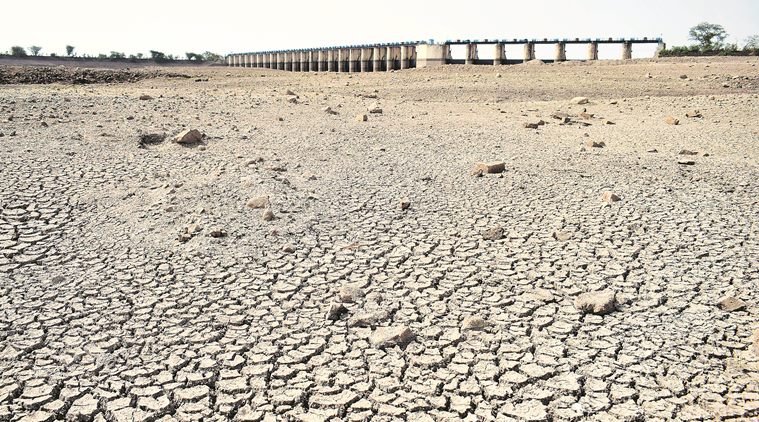- India
- International
Mercury rises in state, water levels in dams fall and Pune residents brace for water cuts
With dam reserves fast depleting, municipal corporations and councils are being forced to impose water cuts in this precarious situation. The Indian Express reviews the present situation and explains what lies ahead as the parched state awaits the monsoon
 The water of Ghod dam, at Wadgaon Shindodi in Pune district, has dried up in the extreme heat. (Express photo by Varun Jha)
The water of Ghod dam, at Wadgaon Shindodi in Pune district, has dried up in the extreme heat. (Express photo by Varun Jha)
Maharashtra is experiencing one of the hottest summers in recent times and the soaring temperatures have directly hit water sources and their supply to various parts of the state. With dam reserves fast depleting, municipal corporations and councils are being forced to impose water cuts in this precarious situation.
The Indian Express reviews the present situation and explains what lies ahead as the parched state awaits the monsoon
Water cuts likely after Monday
The water supply in Pune comes from four dams — Khadakwasla, Panshet, Varasgaon and Temghar — and the water quota is decided by the state government on the basis of recommendations by the state Water Resource and Irrigation Department, which takes into consideration factors such as the population of the city. The department, while allotting quotas, gives priority to drinking water needs, irrigation and industry.
The Pune Municipal Corporation (PMC), which draws nearly 1,600 MLD (million litres per day) water every day for the city, has been at loggerheads with the Water Resource Department over the amount of water drawn by it.
The civic body is finally expected to impose water cuts once polling in the state for the Lok Sabha elections gets over on Monday.

The department will first review the availability of water in nearby dams and then prepare a report seeking permission to reduce its supply to the PMC. The review ensures that the amount of water left is enough to last in the months before the monsoon.
The canal committee, which is part of the district guardian minister’s responsibility, will then discuss the Irrigation Department’s report and seek the state government’s decision on distribution of water for various purposes. If there is a need to reduce water supply for drinking purposes, then the concerned civic body would be asked to introduce cuts so that the water lasts longer.
Dams dry up
This summer has been extremely hot, with heatwave conditions looming over Maharashtra since March.
The situation has worsened in April, with the mercury remaining over 40 degrees Celsius for more than a month in Vidarbha and Marathwada, while the rate of evaporation of surface water reserves is at an all-time high.
The rapidly depleting live water stock in the dams in the state is worrying. In the Pimpalgaon, Ghod, Vadaj, Visapur, Chaskaman, Dadiwale, Kasarsai, Temghar, Khadakwasla and Nazre dams, all of which are linked to the Bhima river basin, the live water stock has fallen below 1 TMC (thousand million cubic feet). The water stock in one of the largest dams, the Ujjani, is already 32 per cent deficit this year.
The situation in the Krishna river basin is far better, as the live water stock in reservoirs continues to range between 22 per cent and 44 per cent, as of April 27. According to the weekly live water stock report issued by the Central Water Commission (CWC), the water reserve in all the dams located in Maharashtra, as on April 25, was 40 per cent below normal.
Water tankers come at a price
With municipal corporations and councils limiting water supply, the demand for other sources of water increases and many local residents resort to using water tankers. Between March and April this year, the number of villages in the state that use water from tankers has jumped by 30 per cent, according to the weekly water tanker data furnished by the state Department of Water Supply and Sanitation.
The situation in April last year was much better, with only 784 tankers required for a total of 758 villages in the state, that is approximately one tanker per village. This summer, Aurangabad alone has 980 villages that have started using tankers, while Beed has 747 of them. Some other villages in dire need of water are in Jalna (443), Nashik (238), Solapur (205), Satara (189), Sangli (173), Pune (131), Jalgaon (130) and Osmanabad (110) districts.
With the soaring demand, the price of water can range from Rs 700 to Rs 3,000 per tanker, depending on its capacity.
Rampant borewell digging
As the water supply is dwindling and the monsoon is still one-and-a-half months away, residents are desperate to get water not just for drinking but for other purposes as well. Digging borewells during the night has become a common affair in Pune and its neighbourhoods. Some wells are dug as deep as up to 200 feet below the ground, flagrantly flouting the 60-foot limit set by the Groundwater Survey and Development Authority for urban areas.
(With inputs from Ajay Jadhav)
Click here to join Express Pune WhatsApp channel and get a curated list of our stories
Apr 23: Latest News
- 01
- 02
- 03
- 04
- 05






































